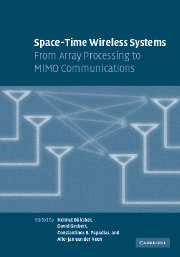Book contents
- Frontmatter
- Contents
- List of contributors
- Acknowledgments
- Introduction
- Part I Multiantenna basics
- Part II Space-time modulation and coding
- Part III Receiver algorithms and parameter estimation
- 12 Array signal processing
- 13 Optimal subspace techniques for DOA estimation
- 14 Blind and semiblind MIMO channel estimation
- 15 MIMO receive algorithms
- 16 Space-time turbo coding
- 17 Training for MIMO communications
- Part IV System-level issues of multiantenna systems
- Part V Implementations, measurements, prototypes, and standards
- Index
17 - Training for MIMO communications
Published online by Cambridge University Press: 25 February 2010
- Frontmatter
- Contents
- List of contributors
- Acknowledgments
- Introduction
- Part I Multiantenna basics
- Part II Space-time modulation and coding
- Part III Receiver algorithms and parameter estimation
- 12 Array signal processing
- 13 Optimal subspace techniques for DOA estimation
- 14 Blind and semiblind MIMO channel estimation
- 15 MIMO receive algorithms
- 16 Space-time turbo coding
- 17 Training for MIMO communications
- Part IV System-level issues of multiantenna systems
- Part V Implementations, measurements, prototypes, and standards
- Index
Summary
In this chapter, an overview of training signal design for multiple-input multiple-output (MIMO) systems is provided with basic theoretical frameworks related to parameter estimation and information theory, as well as generalization and practical issues.
Introduction
Many MIMO communication systems and space-time techniques, for example, BLAST (Foschini, 1996), are designed for coherent detection, which requires channel state information for successful decoding. To facilitate channel estimation and synchronization in such systems, training or pilot signals are usually embedded in transmitted data streams. The design of these training signals can affect significantly the overall performance of a wireless system.
Since the use of training signals reduces effective data throughput, it is natural to seek optimal design of these embedded signals; one may ask “how many training symbols are necessary?” or “what is the optimal pilot sequence and its placement within data streams?”
Optimal training design for MIMO systems is a challenging task since the number of channel parameters to estimate increases rapidly as the number of transmitting and receiving antennas increases. Optimality of design depends on various factors such as receiver implementation, channel model, and design criteria. Although receiver architecture must be taken into account, training design is primarily a transmitter technique. Once a training scheme is chosen, it may be standardized for a specific application. It is therefore important that a training scheme is optimal or near optimal for a wide range of channel conditions and receiver implementations.
- Type
- Chapter
- Information
- Space-Time Wireless SystemsFrom Array Processing to MIMO Communications, pp. 342 - 362Publisher: Cambridge University PressPrint publication year: 2006
- 2
- Cited by



